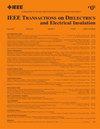The Excitation Effect of X-Ray on Partial Discharge of Bush-Type Electrical Tree in Epoxy Resin
IF 3.1
3区 工程技术
Q2 ENGINEERING, ELECTRICAL & ELECTRONIC
IEEE Transactions on Dielectrics and Electrical Insulation
Pub Date : 2025-06-13
DOI:10.1109/TDEI.2025.3579451
引用次数: 0
Abstract
The partial discharge (PD) signals of bush-type electrical tree defects in epoxy resin are weak, intermittent, and challenging to detect, posing serious threats to insulation performance of power equipment. In response, a PD test method is suggested with X-ray irradiation. To verify its effectiveness, the discharge characteristics of bush-type electrical tree samples at different degradation stages were systematically measured under X-ray irradiation. Experimental results demonstrate that X-ray irradiation exhibits an excitation effect on electrical tree PD at all stages except the first stage (S1). Specifically, during the second stage (S2), X-ray irradiation amplified the maximum discharge magnitude (x射线对环氧树脂丛型电子树局部放电的激发效应
环氧树脂套管型电气树缺陷局部放电信号微弱、间歇性、检测难度大,对电力设备的绝缘性能构成严重威胁。为此,建议采用x射线照射PD检测方法。为了验证其有效性,在x射线照射下系统测量了不同降解阶段的灌木型电树样品的放电特性。实验结果表明,x射线辐照在除第一阶段外的所有阶段都对电树PD有激发作用(S1)。其中,在第二阶段(S2), x射线照射使最大放电幅度(${Q}_{\max}$)增加了17.17倍,最大脉冲重复率(PRRmax)增加了2.6倍。在第三阶段(S3), x射线照射使${Q}_{\max}$增加4.1倍,PRRmax增加2.5倍。在4.1期(S4.1), x射线照射使${Q}_{\max}$增加了3.1倍,PRRmax大大增加。对于阶段4.2 (S4.2), x射线照射可以激发停止放电。x射线通过电离电树中的气体,为局部放电提供初始电子,维持散流传播,减少局部放电的统计延迟。该研究为环氧树脂电气树缺陷的PD检测提供了一种新的方法。
本文章由计算机程序翻译,如有差异,请以英文原文为准。
求助全文
约1分钟内获得全文
求助全文
来源期刊
CiteScore
6.00
自引率
22.60%
发文量
309
审稿时长
5.2 months
期刊介绍:
Topics that are concerned with dielectric phenomena and measurements, with development and characterization of gaseous, vacuum, liquid and solid electrical insulating materials and systems; and with utilization of these materials in circuits and systems under condition of use.

 求助内容:
求助内容: 应助结果提醒方式:
应助结果提醒方式:


